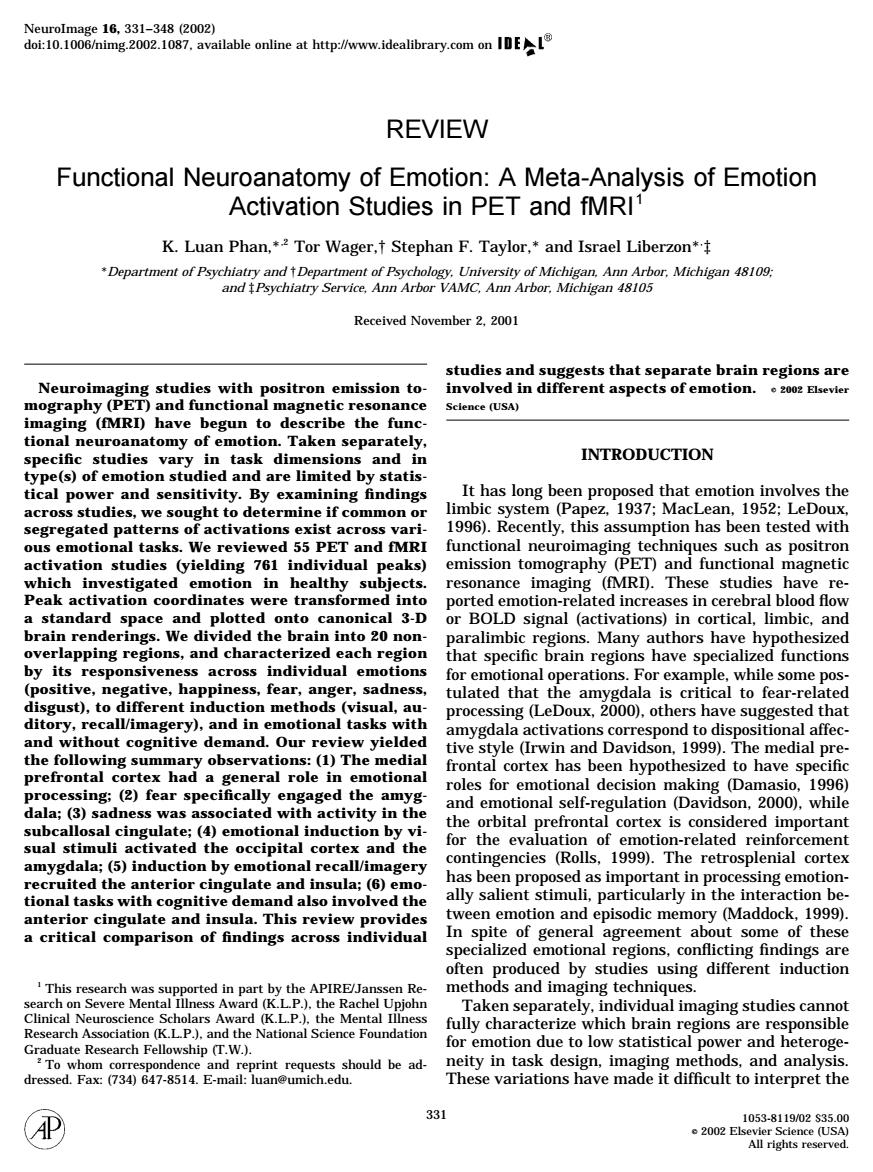正在加载图片...

Aoioegnigza3l8s0galabeonlneatmtpzAiheabrayeomnlnE大le REVIEW Functional Neuroanatomy of Emotion:A Meta-Analysis of Emotion Activation Studies in PET and fMRI1 K.Luan Phan.Tor Wager,t Stephan F.Taylor.and Israel Liberzon Received November 2.2001 studies with ositron to olved in brain regions are ography PE ic re Sclence (USA) ging (IMK to d va in task dir INTRODUCTION e(s)o and are I It has long been proposed that emotion involves the ht to determin (Pa pez,1937:Mac exis acro ntly.thi en t vielding 761 emission tomography PE nd functional magnetic which in stigated in healthy cts resonance imaging (fMRD).These studies have re Peak acti trans】 ported emot on-relat increase in cerebral blo s h d each r gion that specific brain regions have specialized functions by disgust),to 0 ar-r different induction methods(visual, d tha and In 10 amygdala activations o ond to dis affec the foll (L)The me tive style(Irwin and Davidson 1999) had corte prefronta al role dala:()sad ed with act ty in the and e .2000.wh the orbital prefrontal cortex is considered important emoti nd action by for the related rein ement e o pital he 19989tio retrosplenial rte ited the anterior ate ar sula tasks with ally salient stimuli,particularly in the interaction be cogn Ive de ved th tween emotion and episodic memory (Maddock,1999). critical ce gener greer ab some or thes sing different induction This arch ed in e APIRE/Ja methods and imaging techniques. Severe part b aken separately,individual im ence rd( al I naging studies ca on due to lou arch fel hip T.W.) nd her ity in task design.ima PREVIEW Functional Neuroanatomy of Emotion: A Meta-Analysis of Emotion Activation Studies in PET and fMRI1 K. Luan Phan,*,2 Tor Wager,† Stephan F. Taylor,* and Israel Liberzon*, ‡ *Department of Psychiatry and †Department of Psychology, University of Michigan, Ann Arbor, Michigan 48109; and ‡Psychiatry Service, Ann Arbor VAMC, Ann Arbor, Michigan 48105 Received November 2, 2001 Neuroimaging studies with positron emission tomography (PET) and functional magnetic resonance imaging (fMRI) have begun to describe the functional neuroanatomy of emotion. Taken separately, specific studies vary in task dimensions and in type(s) of emotion studied and are limited by statistical power and sensitivity. By examining findings across studies, we sought to determine if common or segregated patterns of activations exist across various emotional tasks. We reviewed 55 PET and fMRI activation studies (yielding 761 individual peaks) which investigated emotion in healthy subjects. Peak activation coordinates were transformed into a standard space and plotted onto canonical 3-D brain renderings. We divided the brain into 20 nonoverlapping regions, and characterized each region by its responsiveness across individual emotions (positive, negative, happiness, fear, anger, sadness, disgust), to different induction methods (visual, auditory, recall/imagery), and in emotional tasks with and without cognitive demand. Our review yielded the following summary observations: (1) The medial prefrontal cortex had a general role in emotional processing; (2) fear specifically engaged the amygdala; (3) sadness was associated with activity in the subcallosal cingulate; (4) emotional induction by visual stimuli activated the occipital cortex and the amygdala; (5) induction by emotional recall/imagery recruited the anterior cingulate and insula; (6) emotional tasks with cognitive demand also involved the anterior cingulate and insula. This review provides a critical comparison of findings across individual studies and suggests that separate brain regions are involved in different aspects of emotion. © 2002 Elsevier Science (USA) INTRODUCTION It has long been proposed that emotion involves the limbic system (Papez, 1937; MacLean, 1952; LeDoux, 1996). Recently, this assumption has been tested with functional neuroimaging techniques such as positron emission tomography (PET) and functional magnetic resonance imaging (fMRI). These studies have reported emotion-related increases in cerebral blood flow or BOLD signal (activations) in cortical, limbic, and paralimbic regions. Many authors have hypothesized that specific brain regions have specialized functions for emotional operations. For example, while some postulated that the amygdala is critical to fear-related processing (LeDoux, 2000), others have suggested that amygdala activations correspond to dispositional affective style (Irwin and Davidson, 1999). The medial prefrontal cortex has been hypothesized to have specific roles for emotional decision making (Damasio, 1996) and emotional self-regulation (Davidson, 2000), while the orbital prefrontal cortex is considered important for the evaluation of emotion-related reinforcement contingencies (Rolls, 1999). The retrosplenial cortex has been proposed as important in processing emotionally salient stimuli, particularly in the interaction between emotion and episodic memory (Maddock, 1999). In spite of general agreement about some of these specialized emotional regions, conflicting findings are often produced by studies using different induction methods and imaging techniques. Taken separately, individual imaging studies cannot fully characterize which brain regions are responsible for emotion due to low statistical power and heterogeneity in task design, imaging methods, and analysis. These variations have made it difficult to interpret the 1 This research was supported in part by the APIRE/Janssen Research on Severe Mental Illness Award (K.L.P.), the Rachel Upjohn Clinical Neuroscience Scholars Award (K.L.P.), the Mental Illness Research Association (K.L.P.), and the National Science Foundation Graduate Research Fellowship (T.W.). 2 To whom correspondence and reprint requests should be addressed. Fax: (734) 647-8514. E-mail: luan@umich.edu. NeuroImage 16, 331–348 (2002) doi:10.1006/nimg.2002.1087, available online at http://www.idealibrary.com on 331 1053-8119/02 $35.00 © 2002 Elsevier Science (USA) All rights reserved